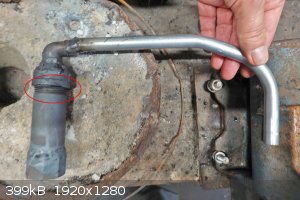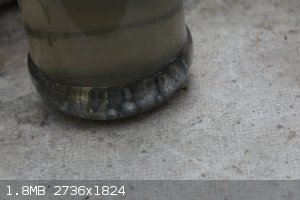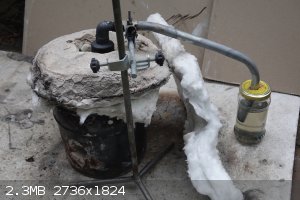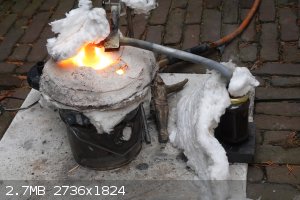metalresearcher
National Hazard
   
Posts: 757
Registered: 7-9-2010
Member Is Offline
Mood: Reactive
|
|
How to seal a stainless steel retort ?
I am experimenting with making phosphorus from NaPO3 + Al + SiO2, which does release P4 vapor when heated to 800 C. Once I succeeded capturing it
under water, but a new attempt resulted in leaking retort (i.e. small bright flames with P2O5 smoke at the joints.
It is a stainless steel 316 vessel made from 1" pipe nipples and a cap on which a steel tube is welded which ends into a jar of water. The cap is
screwed with a 1" pipe thread onto the vessel (red circle) and I used a Kaowool gasket and checked before heating by applying pressure into the tube
end and there were no leaks. Maybe the heat expansion made the weld (yes they are poor, I am not an experienced welder) and the thread leaking.
The SS is not the problem I have heated another similar 316 SS retort many times to 1000 C without problems. I use such retorts for other experiments
as well.
Is there a better way to seal a retort ?
[Edited on 2021-8-13 by metalresearcher]

|
|
|
Fyndium
International Hazard
    
Posts: 1192
Registered: 12-7-2020
Location: Not in USA
Member Is Offline
|
|
Graphite, carbon fiber in place of plumbing hemp, 1500C high temp caulk (made from silicates).
A more enthusiastic welder with access to junkyard with local factory conglomerate producing a lot of 316 crap uses small pipe flanges. Like I do.
 They can be sealed with various methods, from PTFE to graphite gaskets. They can be sealed with various methods, from PTFE to graphite gaskets.
[Edited on 13-8-2021 by Fyndium]
|
|
|
metalresearcher
National Hazard
   
Posts: 757
Registered: 7-9-2010
Member Is Offline
Mood: Reactive
|
|
Finally it succeeded for a KCl + Li to make K metal. First I used a piece of cloth (which will pyrolyze to carbon) which worked and I got beads of K
metal, but they were covered in brownish yellow dirt because of the cloth pyrolysis results dissolved(?) in the mineral oil in the receiver of the
distill setup.
I tried again, but now using Kaowool as 'gasket' which also worked well, I got clean K beads. The only issue I had, was that I had to heat up the top
of the retort again to dull red hot to be able to unscrew it.
 
|
|
|
pneumatician
Hazard to Others
  
Posts: 412
Registered: 27-5-2013
Location: Magonia
Member Is Offline
Mood: ■■■■■■■■■■ INRI ■■■■■■■■■■ ** Igne Natura Renovatur Integra **
|
|
maybe... if you have a broken "vaporeta" or go to a recycle point, get one, remove the plastic parts... this items support a good pressure and the
temp is not a marvel but...
some days ago I open one not working but now is fixed and working again... a fucking disconnected cable.
|
|
|
rockyit98
Hazard to Others
  
Posts: 283
Registered: 12-4-2019
Location: The Known Universe
Member Is Offline
Mood: no mood is a good mood
|
|
try fire place sealant caulk, it's a mix of clay and sodium silicate.
Attachment: 3M-Fire-Block-Sealant-FB-136-SDS-B25103.pdf (50kB)
This file has been downloaded 403 times
"A mind is a terrible thing to lose"-Meisner
|
|
|
metalresearcher
National Hazard
   
Posts: 757
Registered: 7-9-2010
Member Is Offline
Mood: Reactive
|
|
I have such a caulk (but from another manufacturer) for the local hardware store and use it for fixing cracks in furnace parts which works awesome. It
is dark gray but when heated once to over 1000 C it turns white and to my experience in a furnace for melting cast iron it withstands 1500 C. And it
glues very well. That is the reason I am scared that the lid cannot be unscrewed anymore.
|
|
|
metalresearcher
National Hazard
   
Posts: 757
Registered: 7-9-2010
Member Is Offline
Mood: Reactive
|
|
Successful isolation of K but cannot unscrew retort
Today I succeeded making K metal using a different reaction, using K2CO3 + charcoal. It works this way:
K2CO3 (liquid) + 2C (solid) => 2K (gas) + 3CO (gas)
I heated it in a stainless steel retort to 1200 C and captured vapors from the distillation tube in a jar of mineral oil. No leaking occurred. The oil
bath bubbled vigorously and the CO (along with vaporized oil) catched fire which had a purplish color. After 20 minutes bubbling stopped and I let the
stuff cool down.
The retort survived this temperature for the third time, but unscrewing the retort was impossible :-(, so I tried tapping the distillation tube to no
avail. But then some droplets of K came out of the tube, so I put a bucket of water under it to verify if it was potassium metal and and indeed it
reacted with nice purple flames.
https://www.metallab.net/jwplayer/video.php?f=/forums/K_wate...
Then I put the oil jar under the tube end to capture more K.
Now the problem: unscrewing the retort tube. I am thinking about immersing the whole setup in water (and first watch and film the reactions) and let
it immersed overnight, because I think some K metal is condensed and frozen in the thread which inhibits unscrewing ?

|
|
|
Metallophile
Hazard to Self
 
Posts: 87
Registered: 23-3-2018
Member Is Offline
Mood: No Mood
|
|
That should be pretty easy to melt, if it is what's causing the problem. Nice job with this! I'm planning to make my own retort to try to make some Cs
and others. Not sure how I'll heat it though.
|
|
|
Grizli7
Harmless

Posts: 41
Registered: 1-9-2021
Member Is Offline
|
|
If you can find a turner I would recommend you use a self-locking ball fit. Or tapered thread connections. In this case, you do not need to look for
gaskets. You can see a similar connection in diesel high pressure fuel pumps, the fuel line from the pump to the injector. You can also take advantage
of the thermal expansion of metals. If the retort is of 316 and the nut is of 304, clamping will occur with increasing temperature. But with this
approach, it is possible that the connection will need to be polished after each use. In general, 316 is not recommended to be used for a long time at
temperatures above 925 C since scale is formed, perhaps this is important for you, perhaps not.
Well, just look for various oven mixtures with a margin of temperature. This will probably be the cheapest and most affordable option.
|
|
|
Fyndium
International Hazard
    
Posts: 1192
Registered: 12-7-2020
Location: Not in USA
Member Is Offline
|
|
Ah, of course, the compression fittings. Now I'm sad I did not recover those from the junkyard when I handled them. They basically consists of a
threaded adapter with either ball shaped or cone shaped internal parts, which seal upon screwing tight. Smaller versions are used in plumbing and gas
lines.
Hydraulic blocks are actually just machined to high tolerances and mated directly. They will usually seal perfectly, and any microscale cavities will
be quickly blocked as used. Hobbyist could manufacture such parts by getting a true surface, sandpaper and just honing the surfaces till mirror finish
and mating them up with good torque.
|
|
|
Fantasma4500
International Hazard
    
Posts: 1681
Registered: 12-12-2012
Location: Dysrope (aka europe)
Member Is Offline
Mood: dangerously practical
|
|
make a flange
2 pieces of plate welded together
drill holes in both
you can potentially take the bottom one and tap holes in
then you bolt them together with some distance in between, 10mm or more
weld them to your pipe and done
but you still want something in between the pipes, im thinking maybe copper could work, a soft metal
lead is out of the question if you go +300*C
maybe if the pipe has a perfectly clean cut it will seal airtight with bolts?
maybe re-do the device and have 2 pipe ends machined on a lathe for a perfect fit
i have a 1L 316 device, the top is a threaded pipe fitting a threaded end cap with stainless pipe welded onto it, heating on the bottom would save the
top a bit unless the whole device needs to be redhot glowing, if top doesnt get very hot teflon tape could work
|
|
|
Texium
|
Thread Moved
29-11-2023 at 22:11 |